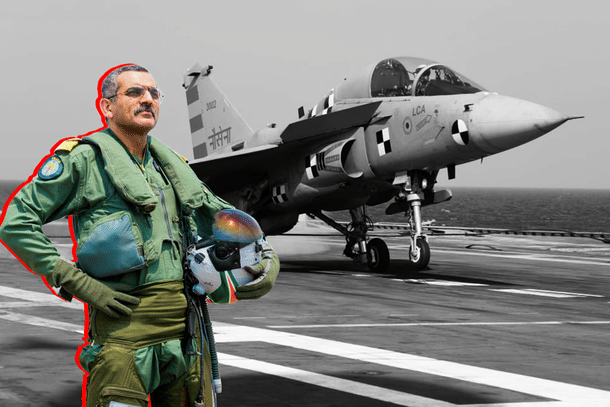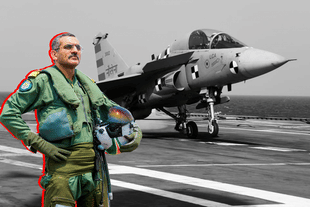Defence
Test Pilot Who Made First LCA Navy Landing On Aircraft Carrier Talks About The Fighter Programme
Swarajya Staff
Feb 19, 2022, 07:19 PM | Updated 07:19 PM IST
Save & read from anywhere!
Bookmark stories for easy access on any device or the Swarajya app.


Commodore Jaideep Maolankar, who conducted the maiden landing of the naval version of Light Combat Aircraft (LCA) Tejas ( called LCA Navy) on aircraft carrier INS Vikramaditya in January 2020, has discussed in detail his experience during the programme in a multi-part conversation on the Blue Skies Podcast.
Maolankar, who served as the Chief Test Pilot of National Flight Test Centre, was commissioned into the Navy in 1985, selected and trained as a naval aviator in 1987, and became a test pilot, a graduate of the Indian Air Force Test Pilot School in Bengaluru in 1994.
Commodore Maolankar's first contact with the LCA Navy programme began when a "massive fat document" related to the project landed on his table.
"I was made to write the Navy's comments on [the project]. This was my first interaction with the LCA Navy," Maolankar says in a conversation with P R Ganapathy, the host of the Blue Skies Podcast.
"So around 2005, I had pretty much finished with my mandatory QRs as a commander in the Navy...So that's about the time when they start pulling you out for giving back to the Navy and make you do staff jobs. So all the fun jobs are over, and now the hard work starts...And I kind of kept touch with kept track of where the LCA was going and what little bit of news used to come out occasionally once in a while, but it was pretty much deadly fear of being stuck behind a desk, which is when this thing came about that that's about the time when NFTC was also being asked to start providing inputs and feedback for the LCA Navy program," he says.
'Ambitious, but a recipe for failure'
Talking about LCA Navy, Maolankar says the plan was to piggyback on the work done for the air force version of the LCA.
"So the basic concept of the LCA Navy program was that piggybacking on the efforts and the investments that have been made in the Air Force Tejas, they would attempt to build a carrier-borne aircraft. Now, when I'm saying it like this now, it does sound, you can straight away, see everybody rolling their eyes," Maolankar says, adding, "The LCA program by itself was an extremely ambitious program. From nothing, you are straight away jumping to a Fourth Gen aircraft in the package of a final finished product...So as it is, very ambitious. Now, on top of that, you add carrier-borne to it and actually it is a recipe for failure."
Maolankar says that the LCA Navy programme was disadvantaged by the need to limit changes when converting the fighter designed for the Air Force to one for carrier operations.
"Because it was defined as a piggyback program, there was a need to minimise the extent of changes. So typically even when you take a land based aircraft and make it carrier based, you typically end up with bigger wings because you're trying to cut down the approach speed. Now here the wing itself was a very significant investment in design and all the wind tunnel work and all the data that had been created, et cetera, the carbon fibre layup work, the structural work that is associated with the wing. So you couldn’t touch the wing, for example," he says.
"So you can see how we are very rapidly piling on the constraints and still retaining an expectation of lightest in the world, multi-role, carrier-borne fighter. Ambitious, clearly, clearly, very ambitious," he adds.
'First live Derby'
Maolankar was involved in the integration of the Derby missile onto the LCA.
When we did the first live Derby, I was a safety pilot. I was planning the sortie and kind of monitoring and controlling the sortie. The Derby, I was the most familiar with it because I had done Derby on the Sea Harrier. So I was most familiar with the Derby systems, et cetera. So I had spent a lot of effort in the integration of the Derby onto the LCA also. It was actually a low hanging fruit for the LCA program because Derby we were already familiar with because of LUSH," he says.
"Derby had been already specified for LCA Navy by the Navy, because they wanted to have a slightly lighter BVR as compared to, say, Astra. LCA Navy bring-back loads on the carrier, et cetera. So they said, why not Derby? So Derby had been specified for LCA Navy. So ADA was already committed to doing a Derby integration on an LCA, which kind of makes ultimate sense. Why not for the Air Force also. And you'll get a quick, really quick and easy within the same original plan cost, you got a BVR capability for the Air Force aircraft also. So that's how the Derby of the thing came about," Maolankar adds.
'A fighting chance'
When asked if the Tejas will give a reasonably trained pilot a fair fighting chance in combat, Maolankar said the platform is better than many currently in service, including in front line service.
"You are in with a fighting chance. You're definitely better than many of the several of the current platforms which are in service, which we are putting in, which are still fielding in front line service. There is no doubt that it is a big step up from there. Does it give you sufficient capability to make tactics and training the deciding factors? Definitely, Maolankar said.
"That there should be absolutely no doubt about the best part of the whole thing is if you identify a weakness in it, you have all the tools and resources at hand to be able to overcome that, maybe even within days, if need be, during a conflict itself. You have the potential to be able to overcome a deficiency if you feel the need, which is not true with," he added.
Ganapathy's two-part conversation with Maolankar, which runs into hours, is available on the Blue Skies Podcast website and their YouTube channel.




